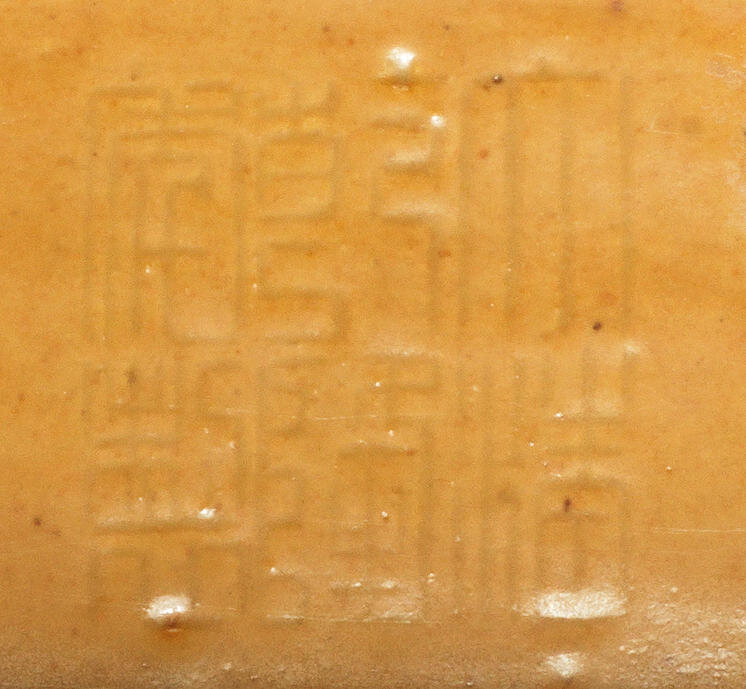A rare flambé-glazed rectangular pear-shaped vase, hu, Incised Qianlong seal mark and of the period (1736-1795)

Lot 41. A rare flambé-glazed rectangular pear-shaped vase, hu, Incised Qianlong seal mark and of the period (1736-1795); 30.5cm (12in) high. Estimate £60,000 - 80,000 (€73,000 - 97,000). Sold for £ 68,500 (€ 76,885). Photo Bonhams
The pear-shaped vessel covered in a rich purple transmutation glaze streaked with mottled sky-blue, thinning to a light beige at the mouth rim, the edges of the square tubular handles and the moulded channels on the neck, all running down to a neatly ground footrim, the glaze with typical triangular pin-pricks, the body with moulded peach-shaped panels to each side, the base and inside footrim with an ochre glaze over the incised zhuanshu mark.
Provenance: The collection of Rear-Admiral Sir Nigel Stuart Henderson, GBE, KCB, DL (1909-1993), and Lady Catherine Mary Henderson (1915-2010), Hensol, Castle Douglas, Kirkcudbrightshire, Scotland.
Note: The inspiration for the flambé glaze can be traced back to the splashed Jun wares of the Song Dynasty. However this particular red glaze, derived from copper but also containing lead, was exceptionally unstable and difficult to control in the kiln, resulting in the highest failure rate of all Chinese glazes. It was not until an extraordinary technical mastery was developed during the Qing period, and the Qianlong reign in particular, that successful flambé-glazed porcelain could be produced, highlighting the exceptional quality and rarity of the present lot. The unusual shape of the hu vase, with its corners, handles and low-raised boss on each side, presented additional possibilities for streaking and pooling for the craftsman to explore.
A number of examples of this type of vase are in museum and private collections: one in the British Museum is illustrated by R.L.Hobson, Chinese Pottery and Porcelain, Vol.II, Ming and Ch'ing Porcelain, London, 1915, pl,.23, fig.1, and another in the Shandong Museum is illustrated by Ma Xigui (ed.), Beauty of Ceramics: Gems of the Official Kilns, Shandong, no.146. A very similar vase in the Huaihaitang Collection is illustrated by P.Lam, Ethereal Elegance: Porcelain Vases of the Imperial Qing: The Huaihaitang Collection, Hong Kong, 2007, no.78, and another in the Tsui Museum of Art is illustrated by Yang Boda, The Tsui Museum of Art: Chinese Ceramics IV: Qing Dynasty, Hong Kong, 1995, no.47.
Compare also a similar flambé-glazed vase, Qianlong seal mark and of the period, sold at Sotheby's Hong Kong, 9 October 2012, lot 3043.
Bonhams. FINE CHINESE ART. London, New Bond Street, 15 May 2014

/https%3A%2F%2Fprofilepics.canalblog.com%2Fprofilepics%2F1%2F0%2F100183.jpg)
/https%3A%2F%2Fstorage.canalblog.com%2F03%2F02%2F119589%2F96711876_o.jpg)
/https%3A%2F%2Fstorage.canalblog.com%2F11%2F31%2F119589%2F94773502_o.jpg)
/https%3A%2F%2Fstorage.canalblog.com%2F20%2F83%2F119589%2F94772815_o.jpg)
/https%3A%2F%2Fstorage.canalblog.com%2F26%2F72%2F119589%2F75604929_o.jpg)
/https%3A%2F%2Fstorage.canalblog.com%2F59%2F60%2F119589%2F26458628_o.jpg)



/http%3A%2F%2Fstorage.canalblog.com%2F63%2F62%2F119589%2F129821675_o.jpg)
/http%3A%2F%2Fstorage.canalblog.com%2F43%2F82%2F119589%2F129801198_o.png)
/http%3A%2F%2Fstorage.canalblog.com%2F40%2F90%2F119589%2F129784381_o.jpg)
/http%3A%2F%2Fstorage.canalblog.com%2F20%2F04%2F119589%2F129784037_o.jpg)